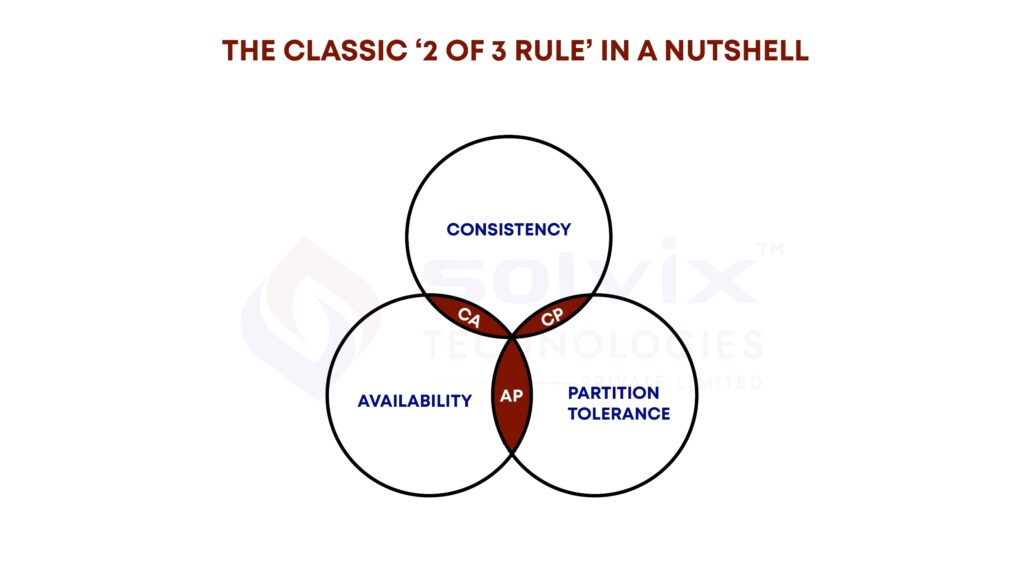No products in the cart.
CAP Theorem in Database Systems: Consistency vs Availability vs Partition Tolerance
Every database system has its limitations. Especially when your application scales and handles real-time user traffic or massive datasets, trade-offs become unavoidable. This is where the CAP Theorem plays a crucial role in helping developers understand the limits of distributed databases.
Let’s break it down not just what the CAP theorem is, but why it matters for database management systems and how it affects the architecture of modern database systems.
What Is the CAP Theorem?
The CAP Theorem, introduced by Eric Brewer in 2000, is a principle that defines three core properties a distributed database system can aim for:
- Consistency
- Availability
- Partition Tolerance
Here’s the twist: a distributed system can only guarantee two out of these three at any given time. You can’t have all three, and that’s not a design flaw—it’s a foundational truth of distributed systems.
Let’s Decode the Three Components

1. Consistency
In database terms, consistency means every read receives the most recent write or an error. If a system claims to be consistent, it ensures that all nodes return the same data, even if some delay is introduced.
- Think of consistency like a synchronized clock. All users, everywhere, see the same time.
- In a consistent database, if a user updates a value, all subsequent reads reflect the updated value immediately.
Strong consistency makes sense in banking or stock trading platforms where outdated data could cause serious issues.
2. Availability
Availability ensures that every request (read/write) gets a non-error response, even if it’s not the latest data.
- Systems built for availability stay responsive, no matter what.
- Even if some nodes are down, the system gives you an answer.
Shopping sites prioritize availability. Showing slightly outdated product counts is better than not loading the page at all.
3. Partition Tolerance
Partition tolerance means the system continues to function even if parts of the network are unavailable or communication between nodes fails.
- In distributed systems, network failures are not rare, they’re expected.
- Partition-tolerant databases are built to handle these hiccups gracefully.
Apps with global users, such as social media platforms or streaming services, must stay operational even if some servers are temporarily cut off.
The Trade-Off: You Can’t Have All Three
When a network partition occurs (which is inevitable in distributed systems), developers face a hard choice:
- CP (Consistency + Partition Tolerance): The system remains consistent and handles partitions, but might sacrifice availability during failure.
Example: HBase
- AP (Availability + Partition Tolerance): The system continues to serve requests and withstands partitions, but data might not be consistent.
Example: Couchbase, Cassandra
- CA (Consistency + Availability): Possible only in theory, without partitions. In other words, not practical in modern distributed setups.
This limitation is the core message of the CAP Theorem.
Why It Matters in Modern Database Design
In real-world applications, network issues can and will happen. So partition tolerance is non-negotiable. That leaves you with the dilemma of choosing between consistency and availability.
Your choice depends on:
- What kind of data you store
- How quickly your users expect a response
- How important up-to-date information is
For instance:
- A ride-hailing app needs availability. It can’t afford to crash every time a node fails.
- A banking system demands consistency. Your balance must be accurate, no exceptions.
Understanding the CAP Theorem helps backend developers and database architects make strategic decisions about which database systems to use and how to configure them.
CAP Theorem and Popular Databases
Different distributed database systems lean toward specific CAP properties based on their design goals. For example, Cassandra and CouchDB are built with availability and partition tolerance (AP) in mind, meaning they’ll always try to respond to requests—even if it means showing slightly outdated data. HBase and Redis (with Sentinel) prioritize consistency and partition tolerance (CP), where data accuracy is more critical, even at the cost of rejecting some requests during network issues.
MongoDB is more flexible, allowing developers to configure it for either CP or AP behavior depending on use case. Traditional SQL-based relational databases aim for consistency and availability (CA) but only work reliably in environments without network partitions—making them less ideal for highly distributed systems. While no system can fully escape CAP trade-offs, understanding their natural leanings helps you plan for failure scenarios more effectively.
Does CAP Theorem Still Hold in 2025?
Yes, but with nuance.
Modern databases often use multi-layered architectures or eventual consistency models to work around the harsh CAP limitations. Systems like DynamoDB or Cosmos DB allow developers to configure consistency levels on a per-query basis.
Still, the CAP theorem remains a reliable mental model when designing or scaling database systems. It forces teams to think: What matters most when the system fails?
Hence, The CAP Theorem isn’t just theory. It’s a practical guide to understanding how distributed database systems behave under stress.
Whether you’re building a real-time app, an e-commerce platform, or a content delivery system, understanding the trade-offs between consistency, availability, and partition tolerance is key to delivering reliable experiences.
